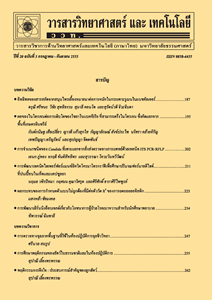Benefits of Fresh Plants in Bird Nests
Main Article Content
Abstract
Some nest-building birds bring fresh plant fragments, e.g. leaves, sprigs or inner bark, which are available in their habitats to build or add in their nests with 3 benefits. Firstly, the olfaction of volatile compounds in aromatic plants can repel or eliminate the ectoparasites and pathogens in the nests. Secondly, fresh plants can keep the nests in the suitable temperature for parental incubation and nestling growth. Thirdly, during courtship period, males use green plant components for attraction females to their nesting sites. These nesting strategies with fresh plants of birds can increase their survival and reproductive success.
Article Details
References
Kler, T.K., 2005, Analysis of nesting material in bird nest boxes, Zoos Print J. 20: 1882.
Sengupta, S., 1981, Adaptive significance of the use of margosa leaves in nests of house sparrows Passer domesticus, Emu. 81: 114-115.
Wimberger, P.H., 1984, The use of green plant material in bird nests to avoid ectoparasites, Auk 101: 615-618.
Freeland, W.J., 1980, Insect flight times and atmospheric hydrocarbons, Am. Nat. 116: 736-742.
Banbura, J., Blondel, J., de Wilde-Lambrechts, H. and Perret, P., 1995, Why do female blue tits (Parus caeruleus) bring fresh plants to their nests?, J. Ornithol. 136: 217-221.
Cowie, R.J. and Hinsley, S.A., 1988, Timing of return with green vegetation by nesting blue tits Parus caeruleus, Biology 130: 553-559.
Lafuma, L., Lambrechts, M.M. and Raymond, M., 2001, Aromatic plants in bird nests as a protection against blood-sucking flying insects?, Behav. Process. 56: 113-120.
Petit, C., Hossaert-McKey, M., Perret, P., Blondel, J. and Lambrechts, M.M., 2002, Blue tits use selected plants and olfaction to maintain an aromatic environment for nestlings, Ecol. Lett. 5: 585-589.
Lambrechts, M.M. and Santos, A.D., 2000, Aromatic herbs in Corsican blue tit nests: The ‘Potpourri’ hypothesis, Acta Oecologica 21: 175-178.
Mennerat, S., Perret, P. and Lambrechts, M.M., 2009, Local individual preferences for nest materials in a passerine bird, PLoS ONE 4(4): e5104.
Bucher, E.H., 1988, Do birds use biological control against nest parasites?, Parasitol. Today 4: 1-3.
Tomas, G., Merino, S., la Puente, M., Moreno, J., Morales, J. and Lobato, E., 2012, Interacting effects of aromatic plants and female age on nest-dwelling ectoparasites and blood-sucking flies in avian nests, Behav. Process. 90: 246-253.
Ontiveros, D., Caro, J. and Pleguezuelos, J.M., 2007, Green plant material versus ectoparasites in nests of Bonelli’s eagle, J. Zool. 274: 99-104.
Clark, L. and Mason, J.R., 1985, Use of nest material as insecticidal and anti-pathogenic agents by the European starling, Oecologia 67: 169-176.
Clark, L., 1991, The Nest Protection Hypothesis: The Adaptive Use of Plant Secondary Compounds by European Starlings, pp. 204-221, In Loye, J.E., Zuk, M. (Eds.), Bird-parasite Interactions, Ecology, Evolution and Behaviour, Oxford University Press, Oxford.
Clark, L. and Mason, J.R., 1987, Olfactory discrimination of plant volatiles by the European starling, Anim. Behav. 35: 227-235.
Gwinner, H., Oltrogge, M., Trost, L. and Nienaber, U., 2000, Green plants in starling nests: Effects on nestlings, Anim. Behav. 59: 301-309.
Gwinner, H. and Berger, S., 2005, Nestling condition, parasites and green nest material during the breeding season, J. Ornithol. 146: 365-371.
Scott-Baumann, J.F. and Morgan, E.R., 2015, A review of the nest protection hypothesis: does inclusion of fresh green plant material in birds’ nests reduce parasite infestation?, Parasitology 142: 1016-1023.
Dubiec, A., Gozdz, I. and Mazgajski, T.D., 2013, Green plant material in avian nests, Avian Biol. Res. 6: 133-146.
Dawson, R.D., 2011, Does fresh vegetation protect avian nests from ectoparasites?: An experiment with tree swallows, Can. J. Zool. 82: 1005-1010.
Mertens, J.A.L., 1977, Thermal conditions for successful breeding in great tits (Parus major L.), Oecologia 28: 31-56.
Gwinner, H., Capilla-Lasheras, P., Cooper, C. and Helm, B., 2018, ‘Green incubation’: Avian offspring benefit from aromatic nest herbs through improved parental incubation behavior, Proc. R. Soc. B 285: 20180376.
Rodgers, J.A.Jr., Wenner, A.S. and Schwikert, S.T., 1988, The use and function of green nest material by wood storks, Wilson Bull. 100: 411-423.
Alabrudzinaka, J., Kalinski, A., Slomczynski, R., Wawrzyniak, J., Zielinski, P. and Banbura, J., 2003, Effects of nest characteristics on breedimg success of great tits Parus major, Acta Ornithol. 38: 151-154.
Wesolowski, T., Czeszczewik, D., Rowinski, P. and Walankiewicz, W., 2002, Nest soaking in natural holes – a serious cause of breeding failure?, Ornis Fennica. 79: 132-138.
Fauth, P.T., Krementz, D.G. and Hines, J.E., 1991, Ectoparasitism and the role of green nesting material in the European starling, Oecologia 88: 22-29.
Gwinner, H., 1997, The function of green plants in nests of European starlings (Sturnus vulgaris), Behaviour 134: 337-351.
Komdeur, J., Wiersma, P. and Magrath, M., 2002, Paternal care and male mate-attraction effort in the European starling is adjusted to clutch size, Proc. R. Soc. Lond. B. 269: 1253-1261.
Eens, M., Pinxten, R. and Verheyen, R.F., 1993, Function of the song and song repertoire in the European starling (Sturnus vulgaris): An aviary experiment, Behaviour 125: 51-66.
Brouwer, L. and Komdeur, J., 2004, Green nesting material has a function in mate attraction in the European starling, Anim. Behav. 67: 539-548.
Ibanez, L.M., Garcia, R.A., Fiorini, V.D. and Montalti, D., 2018, Lichens in the nests of European starling Sturnus vulgaris serve a mate attraction rather than insecticidal function, Turk J. Zool. 42: 316-322.


